Impact of External Pressure on Blood Donation by Young Australians
VerifiedAdded on 2021/06/22
|14
|3948
|107
Report
AI Summary
This report investigates the potential of external pressure to motivate young Australians (18-30 years old) to become first-time blood donors, addressing the critical need for increased blood supply in Australia. It examines various forms of external pressure, including normative beliefs, role model endorsements, personal requests/contacts, and peer pressure, to determine their impact on donation intentions. The study outlines specific, measurable aspects such as demographic characteristics, motivators and barriers to donation, and perceptions of marketing campaigns designed by the Australian Red Cross Blood Service (ARCBS). A 21-question survey, incorporating multiple-choice, ranking, fill-in-the-blank, and Likert scale questions, is designed to gather data on these aspects. The report acknowledges limitations such as sample size and potential biases inherent in survey methodology, while aiming to provide ARCBS with actionable insights for targeted donor recruitment strategies.
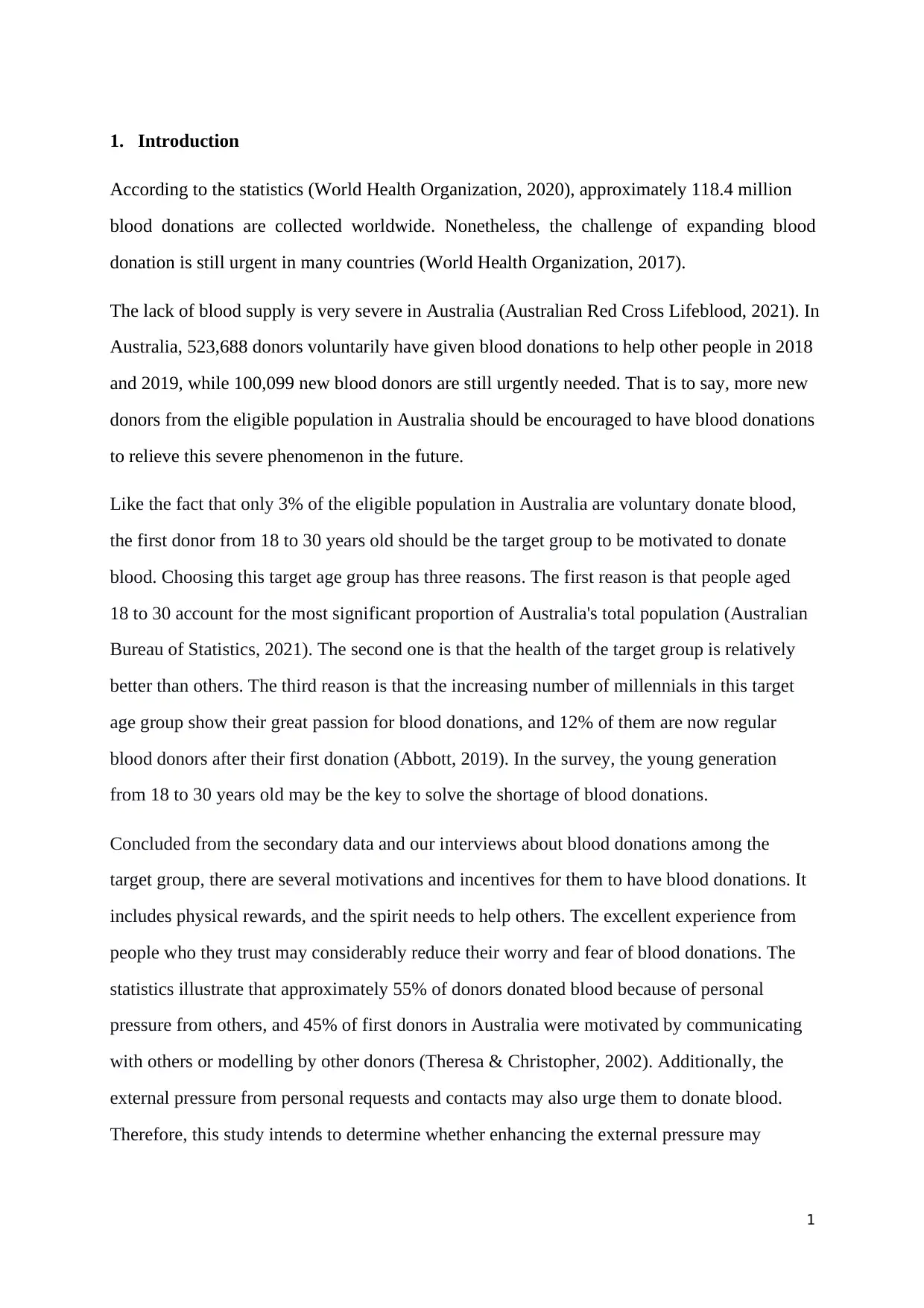
1
1. Introduction
According to the statistics (World Health Organization, 2020), approximately 118.4 million
blood donations are collected worldwide. Nonetheless, the challenge of expanding blood
donation is still urgent in many countries (World Health Organization, 2017).
The lack of blood supply is very severe in Australia (Australian Red Cross Lifeblood, 2021). In
Australia, 523,688 donors voluntarily have given blood donations to help other people in 2018
and 2019, while 100,099 new blood donors are still urgently needed. That is to say, more new
donors from the eligible population in Australia should be encouraged to have blood donations
to relieve this severe phenomenon in the future.
Like the fact that only 3% of the eligible population in Australia are voluntary donate blood,
the first donor from 18 to 30 years old should be the target group to be motivated to donate
blood. Choosing this target age group has three reasons. The first reason is that people aged
18 to 30 account for the most significant proportion of Australia's total population (Australian
Bureau of Statistics, 2021). The second one is that the health of the target group is relatively
better than others. The third reason is that the increasing number of millennials in this target
age group show their great passion for blood donations, and 12% of them are now regular
blood donors after their first donation (Abbott, 2019). In the survey, the young generation
from 18 to 30 years old may be the key to solve the shortage of blood donations.
Concluded from the secondary data and our interviews about blood donations among the
target group, there are several motivations and incentives for them to have blood donations. It
includes physical rewards, and the spirit needs to help others. The excellent experience from
people who they trust may considerably reduce their worry and fear of blood donations. The
statistics illustrate that approximately 55% of donors donated blood because of personal
pressure from others, and 45% of first donors in Australia were motivated by communicating
with others or modelling by other donors (Theresa & Christopher, 2002). Additionally, the
external pressure from personal requests and contacts may also urge them to donate blood.
Therefore, this study intends to determine whether enhancing the external pressure may
1. Introduction
According to the statistics (World Health Organization, 2020), approximately 118.4 million
blood donations are collected worldwide. Nonetheless, the challenge of expanding blood
donation is still urgent in many countries (World Health Organization, 2017).
The lack of blood supply is very severe in Australia (Australian Red Cross Lifeblood, 2021). In
Australia, 523,688 donors voluntarily have given blood donations to help other people in 2018
and 2019, while 100,099 new blood donors are still urgently needed. That is to say, more new
donors from the eligible population in Australia should be encouraged to have blood donations
to relieve this severe phenomenon in the future.
Like the fact that only 3% of the eligible population in Australia are voluntary donate blood,
the first donor from 18 to 30 years old should be the target group to be motivated to donate
blood. Choosing this target age group has three reasons. The first reason is that people aged
18 to 30 account for the most significant proportion of Australia's total population (Australian
Bureau of Statistics, 2021). The second one is that the health of the target group is relatively
better than others. The third reason is that the increasing number of millennials in this target
age group show their great passion for blood donations, and 12% of them are now regular
blood donors after their first donation (Abbott, 2019). In the survey, the young generation
from 18 to 30 years old may be the key to solve the shortage of blood donations.
Concluded from the secondary data and our interviews about blood donations among the
target group, there are several motivations and incentives for them to have blood donations. It
includes physical rewards, and the spirit needs to help others. The excellent experience from
people who they trust may considerably reduce their worry and fear of blood donations. The
statistics illustrate that approximately 55% of donors donated blood because of personal
pressure from others, and 45% of first donors in Australia were motivated by communicating
with others or modelling by other donors (Theresa & Christopher, 2002). Additionally, the
external pressure from personal requests and contacts may also urge them to donate blood.
Therefore, this study intends to determine whether enhancing the external pressure may
Paraphrase This Document
Need a fresh take? Get an instant paraphrase of this document with our AI Paraphraser
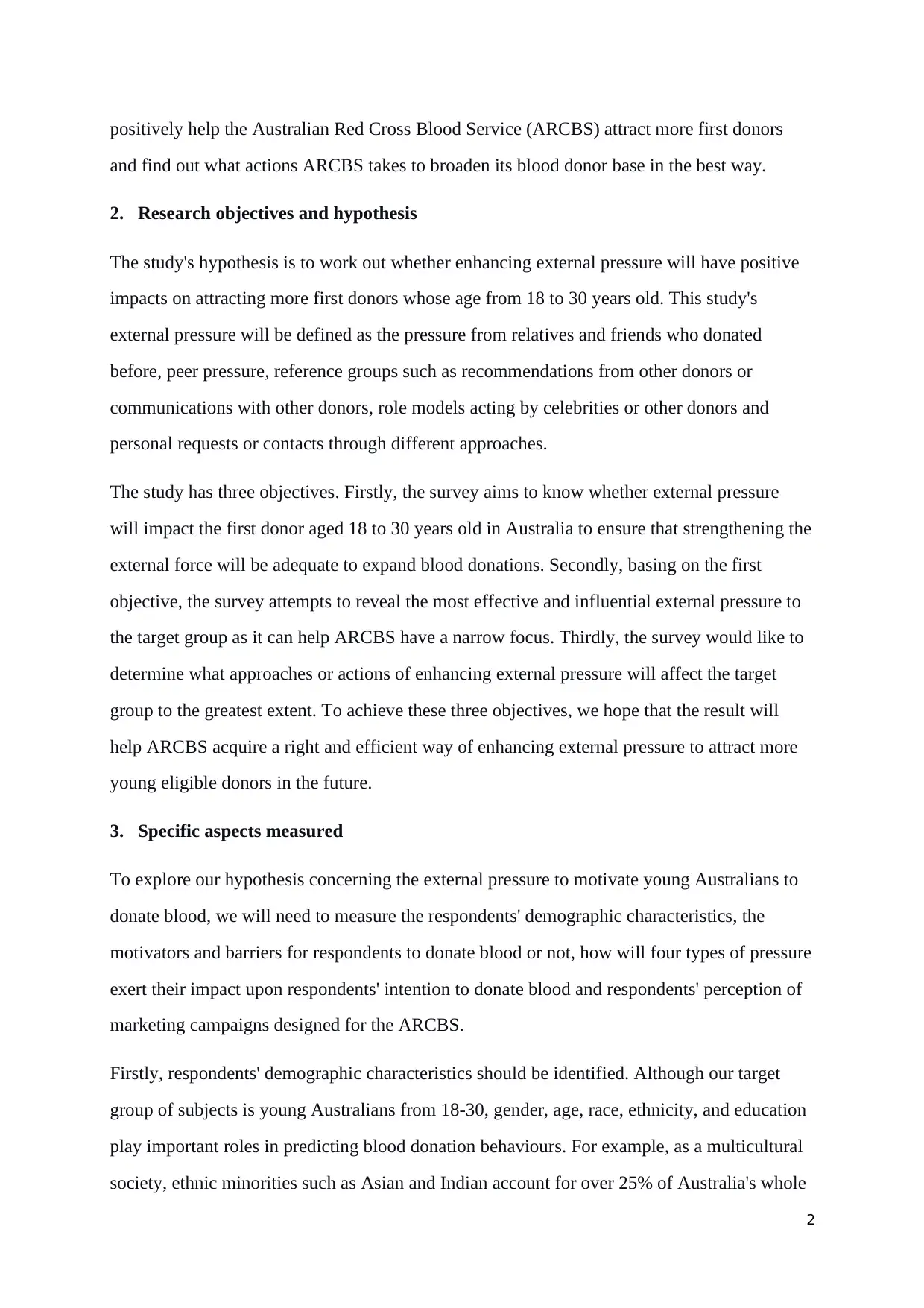
2
positively help the Australian Red Cross Blood Service (ARCBS) attract more first donors
and find out what actions ARCBS takes to broaden its blood donor base in the best way.
2. Research objectives and hypothesis
The study's hypothesis is to work out whether enhancing external pressure will have positive
impacts on attracting more first donors whose age from 18 to 30 years old. This study's
external pressure will be defined as the pressure from relatives and friends who donated
before, peer pressure, reference groups such as recommendations from other donors or
communications with other donors, role models acting by celebrities or other donors and
personal requests or contacts through different approaches.
The study has three objectives. Firstly, the survey aims to know whether external pressure
will impact the first donor aged 18 to 30 years old in Australia to ensure that strengthening the
external force will be adequate to expand blood donations. Secondly, basing on the first
objective, the survey attempts to reveal the most effective and influential external pressure to
the target group as it can help ARCBS have a narrow focus. Thirdly, the survey would like to
determine what approaches or actions of enhancing external pressure will affect the target
group to the greatest extent. To achieve these three objectives, we hope that the result will
help ARCBS acquire a right and efficient way of enhancing external pressure to attract more
young eligible donors in the future.
3. Specific aspects measured
To explore our hypothesis concerning the external pressure to motivate young Australians to
donate blood, we will need to measure the respondents' demographic characteristics, the
motivators and barriers for respondents to donate blood or not, how will four types of pressure
exert their impact upon respondents' intention to donate blood and respondents' perception of
marketing campaigns designed for the ARCBS.
Firstly, respondents' demographic characteristics should be identified. Although our target
group of subjects is young Australians from 18-30, gender, age, race, ethnicity, and education
play important roles in predicting blood donation behaviours. For example, as a multicultural
society, ethnic minorities such as Asian and Indian account for over 25% of Australia's whole
positively help the Australian Red Cross Blood Service (ARCBS) attract more first donors
and find out what actions ARCBS takes to broaden its blood donor base in the best way.
2. Research objectives and hypothesis
The study's hypothesis is to work out whether enhancing external pressure will have positive
impacts on attracting more first donors whose age from 18 to 30 years old. This study's
external pressure will be defined as the pressure from relatives and friends who donated
before, peer pressure, reference groups such as recommendations from other donors or
communications with other donors, role models acting by celebrities or other donors and
personal requests or contacts through different approaches.
The study has three objectives. Firstly, the survey aims to know whether external pressure
will impact the first donor aged 18 to 30 years old in Australia to ensure that strengthening the
external force will be adequate to expand blood donations. Secondly, basing on the first
objective, the survey attempts to reveal the most effective and influential external pressure to
the target group as it can help ARCBS have a narrow focus. Thirdly, the survey would like to
determine what approaches or actions of enhancing external pressure will affect the target
group to the greatest extent. To achieve these three objectives, we hope that the result will
help ARCBS acquire a right and efficient way of enhancing external pressure to attract more
young eligible donors in the future.
3. Specific aspects measured
To explore our hypothesis concerning the external pressure to motivate young Australians to
donate blood, we will need to measure the respondents' demographic characteristics, the
motivators and barriers for respondents to donate blood or not, how will four types of pressure
exert their impact upon respondents' intention to donate blood and respondents' perception of
marketing campaigns designed for the ARCBS.
Firstly, respondents' demographic characteristics should be identified. Although our target
group of subjects is young Australians from 18-30, gender, age, race, ethnicity, and education
play important roles in predicting blood donation behaviours. For example, as a multicultural
society, ethnic minorities such as Asian and Indian account for over 25% of Australia's whole
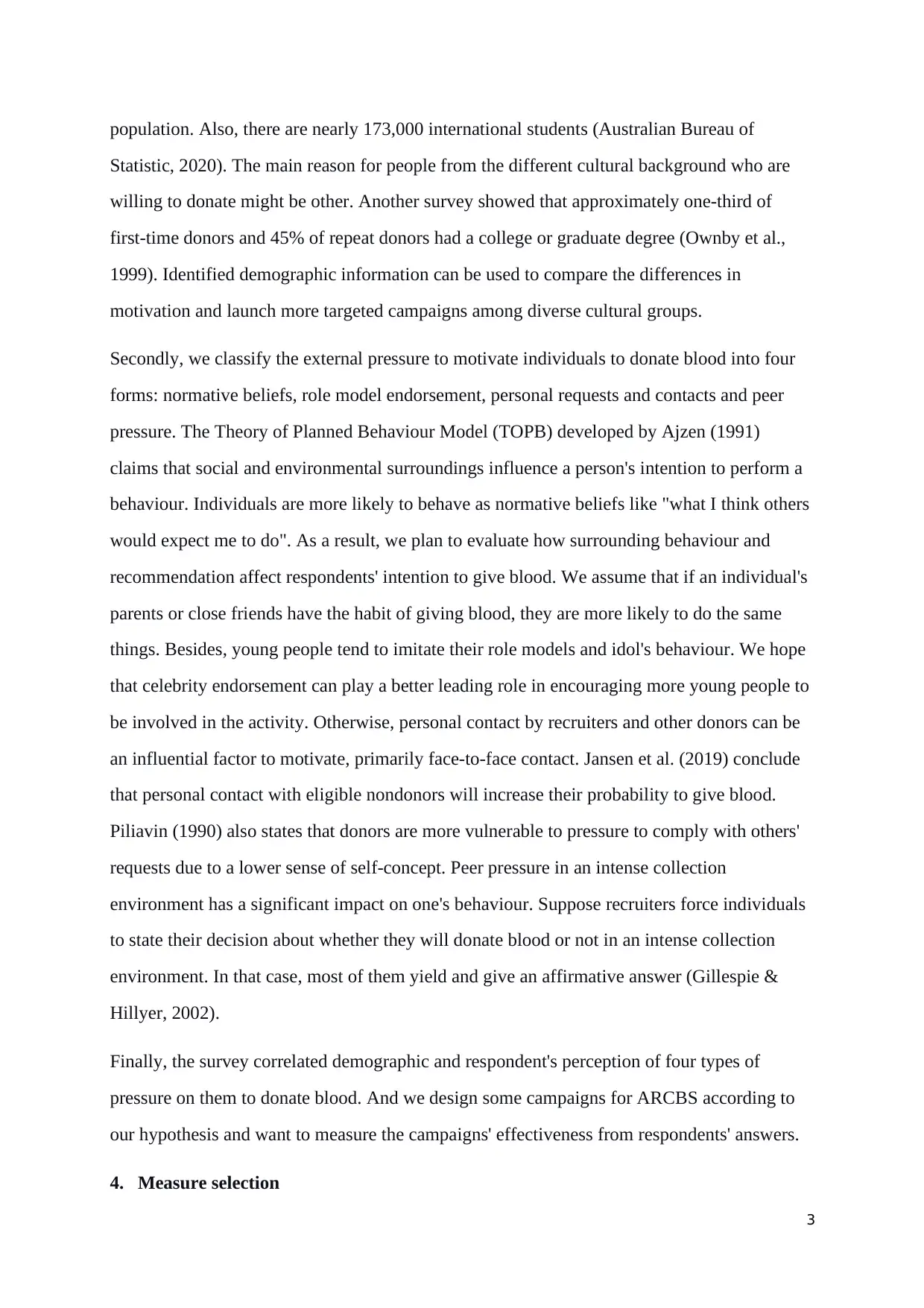
3
population. Also, there are nearly 173,000 international students (Australian Bureau of
Statistic, 2020). The main reason for people from the different cultural background who are
willing to donate might be other. Another survey showed that approximately one-third of
first-time donors and 45% of repeat donors had a college or graduate degree (Ownby et al.,
1999). Identified demographic information can be used to compare the differences in
motivation and launch more targeted campaigns among diverse cultural groups.
Secondly, we classify the external pressure to motivate individuals to donate blood into four
forms: normative beliefs, role model endorsement, personal requests and contacts and peer
pressure. The Theory of Planned Behaviour Model (TOPB) developed by Ajzen (1991)
claims that social and environmental surroundings influence a person's intention to perform a
behaviour. Individuals are more likely to behave as normative beliefs like "what I think others
would expect me to do". As a result, we plan to evaluate how surrounding behaviour and
recommendation affect respondents' intention to give blood. We assume that if an individual's
parents or close friends have the habit of giving blood, they are more likely to do the same
things. Besides, young people tend to imitate their role models and idol's behaviour. We hope
that celebrity endorsement can play a better leading role in encouraging more young people to
be involved in the activity. Otherwise, personal contact by recruiters and other donors can be
an influential factor to motivate, primarily face-to-face contact. Jansen et al. (2019) conclude
that personal contact with eligible nondonors will increase their probability to give blood.
Piliavin (1990) also states that donors are more vulnerable to pressure to comply with others'
requests due to a lower sense of self-concept. Peer pressure in an intense collection
environment has a significant impact on one's behaviour. Suppose recruiters force individuals
to state their decision about whether they will donate blood or not in an intense collection
environment. In that case, most of them yield and give an affirmative answer (Gillespie &
Hillyer, 2002).
Finally, the survey correlated demographic and respondent's perception of four types of
pressure on them to donate blood. And we design some campaigns for ARCBS according to
our hypothesis and want to measure the campaigns' effectiveness from respondents' answers.
4. Measure selection
population. Also, there are nearly 173,000 international students (Australian Bureau of
Statistic, 2020). The main reason for people from the different cultural background who are
willing to donate might be other. Another survey showed that approximately one-third of
first-time donors and 45% of repeat donors had a college or graduate degree (Ownby et al.,
1999). Identified demographic information can be used to compare the differences in
motivation and launch more targeted campaigns among diverse cultural groups.
Secondly, we classify the external pressure to motivate individuals to donate blood into four
forms: normative beliefs, role model endorsement, personal requests and contacts and peer
pressure. The Theory of Planned Behaviour Model (TOPB) developed by Ajzen (1991)
claims that social and environmental surroundings influence a person's intention to perform a
behaviour. Individuals are more likely to behave as normative beliefs like "what I think others
would expect me to do". As a result, we plan to evaluate how surrounding behaviour and
recommendation affect respondents' intention to give blood. We assume that if an individual's
parents or close friends have the habit of giving blood, they are more likely to do the same
things. Besides, young people tend to imitate their role models and idol's behaviour. We hope
that celebrity endorsement can play a better leading role in encouraging more young people to
be involved in the activity. Otherwise, personal contact by recruiters and other donors can be
an influential factor to motivate, primarily face-to-face contact. Jansen et al. (2019) conclude
that personal contact with eligible nondonors will increase their probability to give blood.
Piliavin (1990) also states that donors are more vulnerable to pressure to comply with others'
requests due to a lower sense of self-concept. Peer pressure in an intense collection
environment has a significant impact on one's behaviour. Suppose recruiters force individuals
to state their decision about whether they will donate blood or not in an intense collection
environment. In that case, most of them yield and give an affirmative answer (Gillespie &
Hillyer, 2002).
Finally, the survey correlated demographic and respondent's perception of four types of
pressure on them to donate blood. And we design some campaigns for ARCBS according to
our hypothesis and want to measure the campaigns' effectiveness from respondents' answers.
4. Measure selection
⊘ This is a preview!⊘
Do you want full access?
Subscribe today to unlock all pages.

Trusted by 1+ million students worldwide
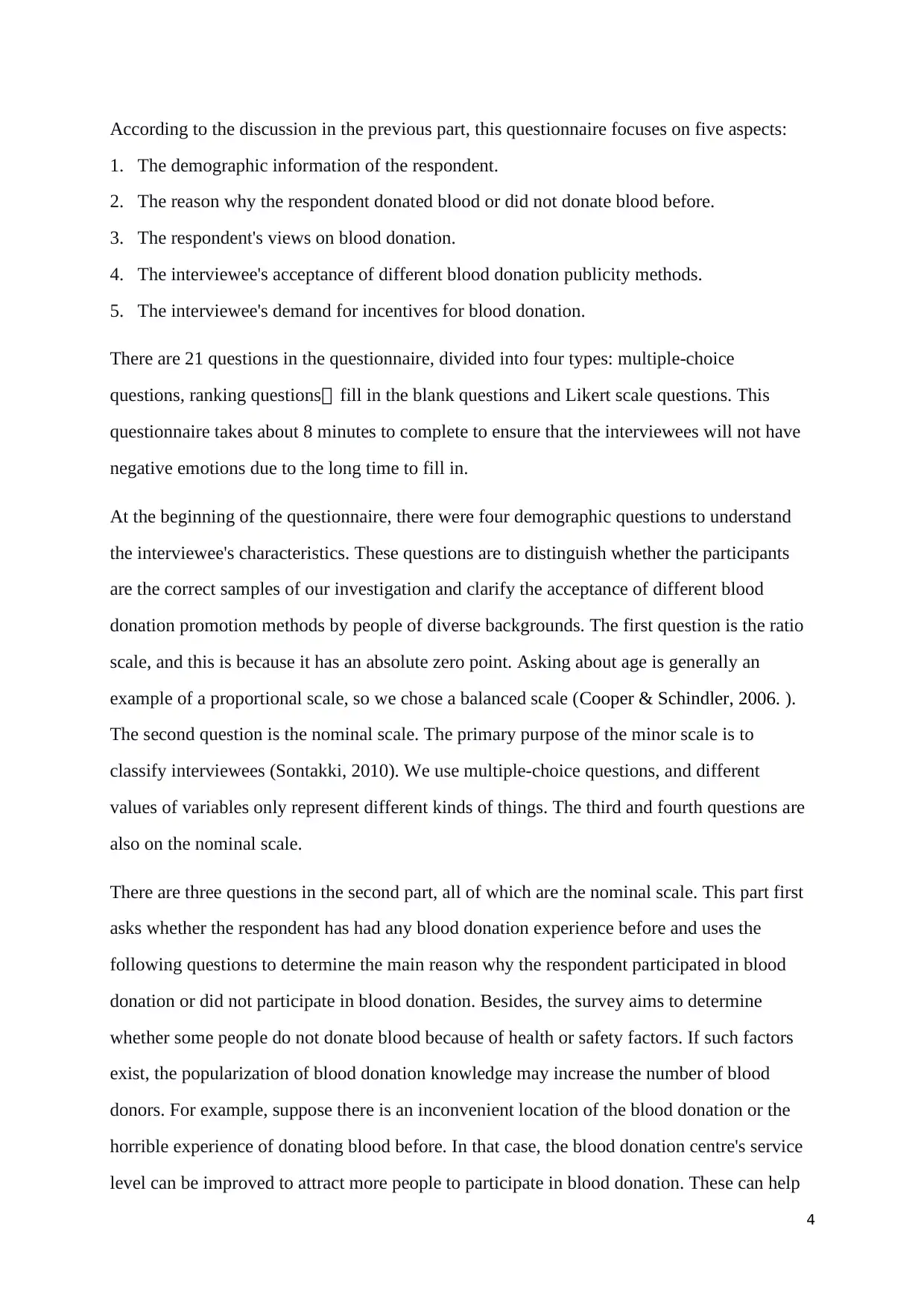
4
According to the discussion in the previous part, this questionnaire focuses on five aspects:
1. The demographic information of the respondent.
2. The reason why the respondent donated blood or did not donate blood before.
3. The respondent's views on blood donation.
4. The interviewee's acceptance of different blood donation publicity methods.
5. The interviewee's demand for incentives for blood donation.
There are 21 questions in the questionnaire, divided into four types: multiple-choice
questions, ranking questions, fill in the blank questions and Likert scale questions. This
questionnaire takes about 8 minutes to complete to ensure that the interviewees will not have
negative emotions due to the long time to fill in.
At the beginning of the questionnaire, there were four demographic questions to understand
the interviewee's characteristics. These questions are to distinguish whether the participants
are the correct samples of our investigation and clarify the acceptance of different blood
donation promotion methods by people of diverse backgrounds. The first question is the ratio
scale, and this is because it has an absolute zero point. Asking about age is generally an
example of a proportional scale, so we chose a balanced scale (Cooper & Schindler, 2006. ).
The second question is the nominal scale. The primary purpose of the minor scale is to
classify interviewees (Sontakki, 2010). We use multiple-choice questions, and different
values of variables only represent different kinds of things. The third and fourth questions are
also on the nominal scale.
There are three questions in the second part, all of which are the nominal scale. This part first
asks whether the respondent has had any blood donation experience before and uses the
following questions to determine the main reason why the respondent participated in blood
donation or did not participate in blood donation. Besides, the survey aims to determine
whether some people do not donate blood because of health or safety factors. If such factors
exist, the popularization of blood donation knowledge may increase the number of blood
donors. For example, suppose there is an inconvenient location of the blood donation or the
horrible experience of donating blood before. In that case, the blood donation centre's service
level can be improved to attract more people to participate in blood donation. These can help
According to the discussion in the previous part, this questionnaire focuses on five aspects:
1. The demographic information of the respondent.
2. The reason why the respondent donated blood or did not donate blood before.
3. The respondent's views on blood donation.
4. The interviewee's acceptance of different blood donation publicity methods.
5. The interviewee's demand for incentives for blood donation.
There are 21 questions in the questionnaire, divided into four types: multiple-choice
questions, ranking questions, fill in the blank questions and Likert scale questions. This
questionnaire takes about 8 minutes to complete to ensure that the interviewees will not have
negative emotions due to the long time to fill in.
At the beginning of the questionnaire, there were four demographic questions to understand
the interviewee's characteristics. These questions are to distinguish whether the participants
are the correct samples of our investigation and clarify the acceptance of different blood
donation promotion methods by people of diverse backgrounds. The first question is the ratio
scale, and this is because it has an absolute zero point. Asking about age is generally an
example of a proportional scale, so we chose a balanced scale (Cooper & Schindler, 2006. ).
The second question is the nominal scale. The primary purpose of the minor scale is to
classify interviewees (Sontakki, 2010). We use multiple-choice questions, and different
values of variables only represent different kinds of things. The third and fourth questions are
also on the nominal scale.
There are three questions in the second part, all of which are the nominal scale. This part first
asks whether the respondent has had any blood donation experience before and uses the
following questions to determine the main reason why the respondent participated in blood
donation or did not participate in blood donation. Besides, the survey aims to determine
whether some people do not donate blood because of health or safety factors. If such factors
exist, the popularization of blood donation knowledge may increase the number of blood
donors. For example, suppose there is an inconvenient location of the blood donation or the
horrible experience of donating blood before. In that case, the blood donation centre's service
level can be improved to attract more people to participate in blood donation. These can help
Paraphrase This Document
Need a fresh take? Get an instant paraphrase of this document with our AI Paraphraser
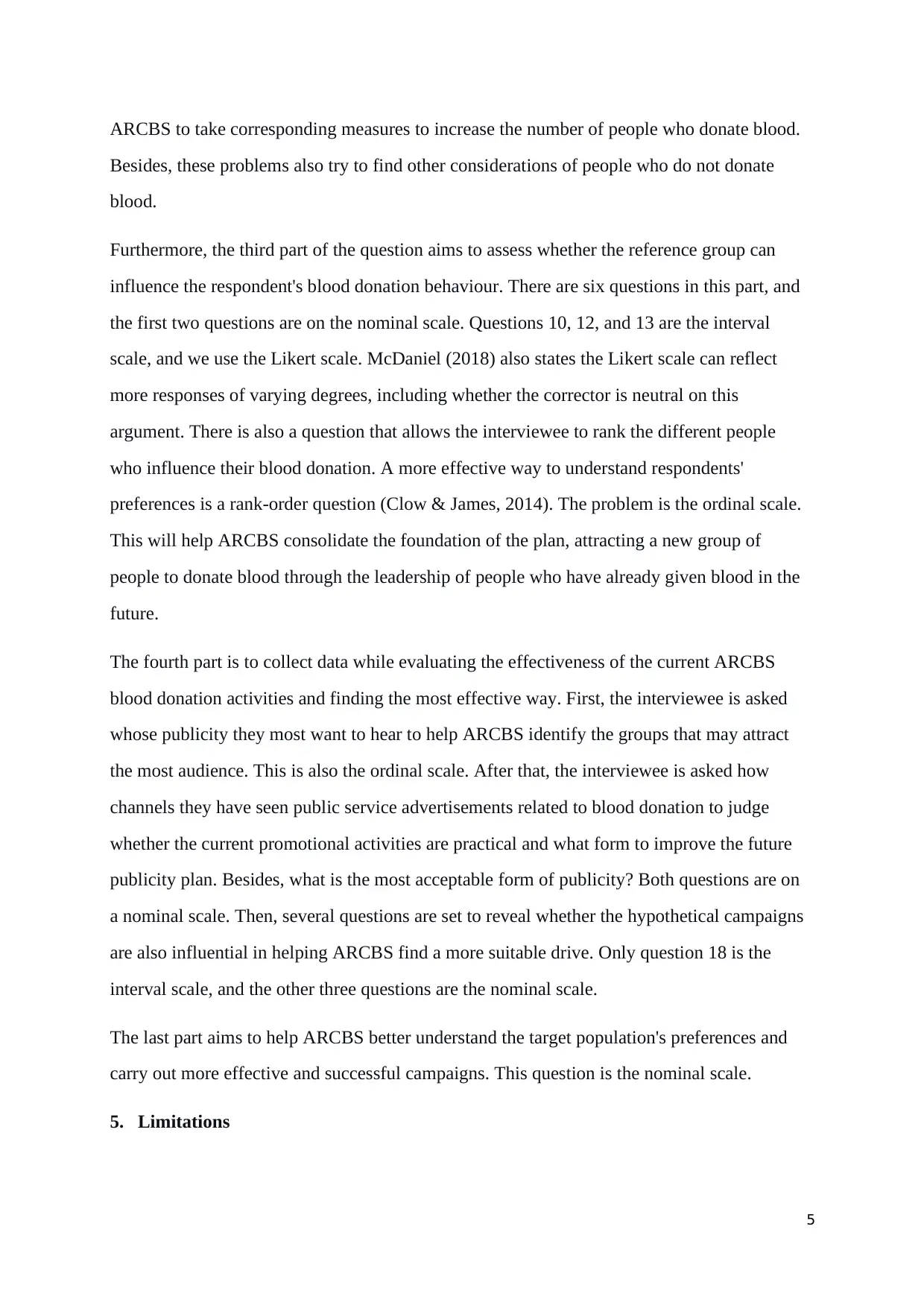
5
ARCBS to take corresponding measures to increase the number of people who donate blood.
Besides, these problems also try to find other considerations of people who do not donate
blood.
Furthermore, the third part of the question aims to assess whether the reference group can
influence the respondent's blood donation behaviour. There are six questions in this part, and
the first two questions are on the nominal scale. Questions 10, 12, and 13 are the interval
scale, and we use the Likert scale. McDaniel (2018) also states the Likert scale can reflect
more responses of varying degrees, including whether the corrector is neutral on this
argument. There is also a question that allows the interviewee to rank the different people
who influence their blood donation. A more effective way to understand respondents'
preferences is a rank-order question (Clow & James, 2014). The problem is the ordinal scale.
This will help ARCBS consolidate the foundation of the plan, attracting a new group of
people to donate blood through the leadership of people who have already given blood in the
future.
The fourth part is to collect data while evaluating the effectiveness of the current ARCBS
blood donation activities and finding the most effective way. First, the interviewee is asked
whose publicity they most want to hear to help ARCBS identify the groups that may attract
the most audience. This is also the ordinal scale. After that, the interviewee is asked how
channels they have seen public service advertisements related to blood donation to judge
whether the current promotional activities are practical and what form to improve the future
publicity plan. Besides, what is the most acceptable form of publicity? Both questions are on
a nominal scale. Then, several questions are set to reveal whether the hypothetical campaigns
are also influential in helping ARCBS find a more suitable drive. Only question 18 is the
interval scale, and the other three questions are the nominal scale.
The last part aims to help ARCBS better understand the target population's preferences and
carry out more effective and successful campaigns. This question is the nominal scale.
5. Limitations
ARCBS to take corresponding measures to increase the number of people who donate blood.
Besides, these problems also try to find other considerations of people who do not donate
blood.
Furthermore, the third part of the question aims to assess whether the reference group can
influence the respondent's blood donation behaviour. There are six questions in this part, and
the first two questions are on the nominal scale. Questions 10, 12, and 13 are the interval
scale, and we use the Likert scale. McDaniel (2018) also states the Likert scale can reflect
more responses of varying degrees, including whether the corrector is neutral on this
argument. There is also a question that allows the interviewee to rank the different people
who influence their blood donation. A more effective way to understand respondents'
preferences is a rank-order question (Clow & James, 2014). The problem is the ordinal scale.
This will help ARCBS consolidate the foundation of the plan, attracting a new group of
people to donate blood through the leadership of people who have already given blood in the
future.
The fourth part is to collect data while evaluating the effectiveness of the current ARCBS
blood donation activities and finding the most effective way. First, the interviewee is asked
whose publicity they most want to hear to help ARCBS identify the groups that may attract
the most audience. This is also the ordinal scale. After that, the interviewee is asked how
channels they have seen public service advertisements related to blood donation to judge
whether the current promotional activities are practical and what form to improve the future
publicity plan. Besides, what is the most acceptable form of publicity? Both questions are on
a nominal scale. Then, several questions are set to reveal whether the hypothetical campaigns
are also influential in helping ARCBS find a more suitable drive. Only question 18 is the
interval scale, and the other three questions are the nominal scale.
The last part aims to help ARCBS better understand the target population's preferences and
carry out more effective and successful campaigns. This question is the nominal scale.
5. Limitations
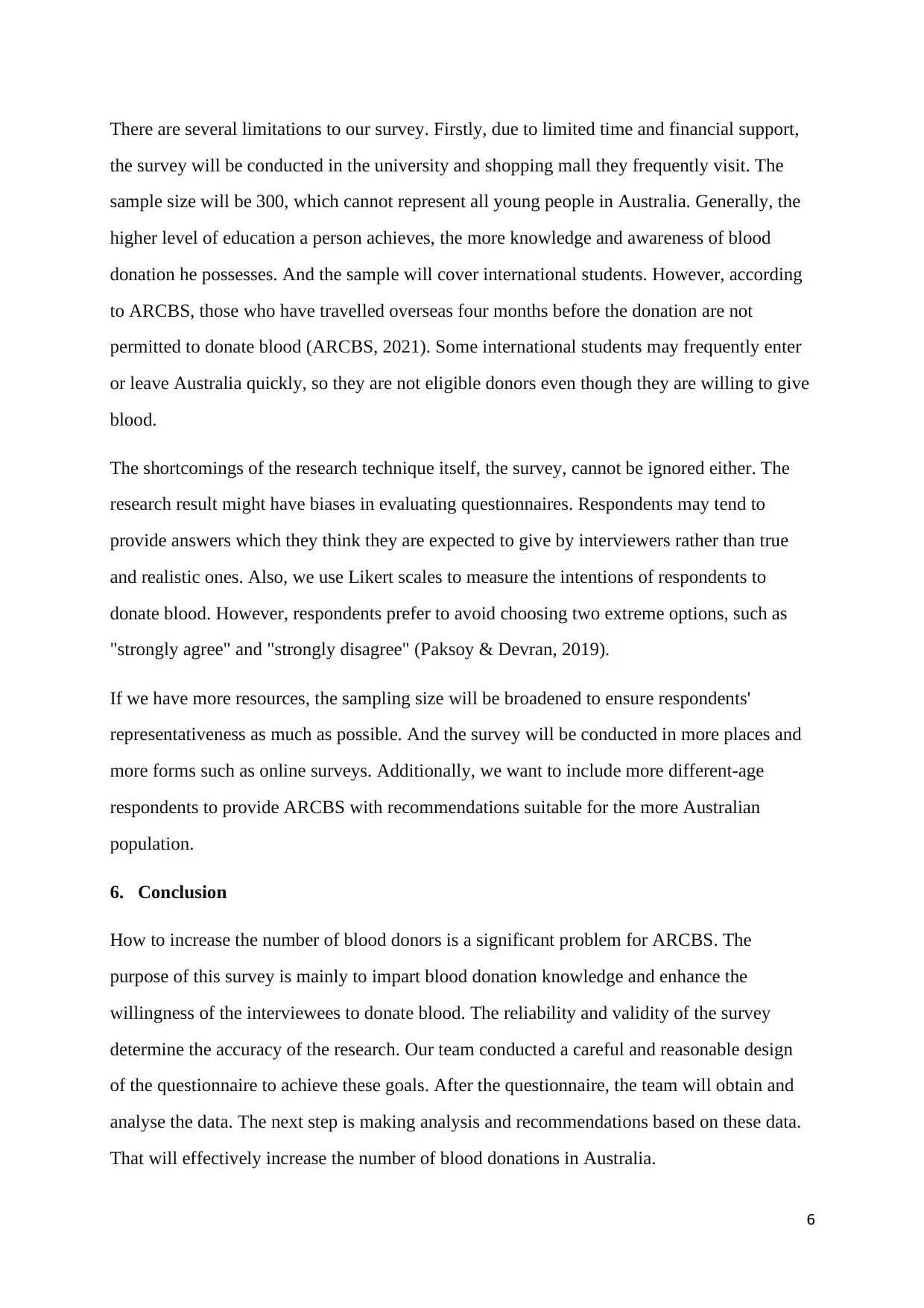
6
There are several limitations to our survey. Firstly, due to limited time and financial support,
the survey will be conducted in the university and shopping mall they frequently visit. The
sample size will be 300, which cannot represent all young people in Australia. Generally, the
higher level of education a person achieves, the more knowledge and awareness of blood
donation he possesses. And the sample will cover international students. However, according
to ARCBS, those who have travelled overseas four months before the donation are not
permitted to donate blood (ARCBS, 2021). Some international students may frequently enter
or leave Australia quickly, so they are not eligible donors even though they are willing to give
blood.
The shortcomings of the research technique itself, the survey, cannot be ignored either. The
research result might have biases in evaluating questionnaires. Respondents may tend to
provide answers which they think they are expected to give by interviewers rather than true
and realistic ones. Also, we use Likert scales to measure the intentions of respondents to
donate blood. However, respondents prefer to avoid choosing two extreme options, such as
"strongly agree" and "strongly disagree" (Paksoy & Devran, 2019).
If we have more resources, the sampling size will be broadened to ensure respondents'
representativeness as much as possible. And the survey will be conducted in more places and
more forms such as online surveys. Additionally, we want to include more different-age
respondents to provide ARCBS with recommendations suitable for the more Australian
population.
6. Conclusion
How to increase the number of blood donors is a significant problem for ARCBS. The
purpose of this survey is mainly to impart blood donation knowledge and enhance the
willingness of the interviewees to donate blood. The reliability and validity of the survey
determine the accuracy of the research. Our team conducted a careful and reasonable design
of the questionnaire to achieve these goals. After the questionnaire, the team will obtain and
analyse the data. The next step is making analysis and recommendations based on these data.
That will effectively increase the number of blood donations in Australia.
There are several limitations to our survey. Firstly, due to limited time and financial support,
the survey will be conducted in the university and shopping mall they frequently visit. The
sample size will be 300, which cannot represent all young people in Australia. Generally, the
higher level of education a person achieves, the more knowledge and awareness of blood
donation he possesses. And the sample will cover international students. However, according
to ARCBS, those who have travelled overseas four months before the donation are not
permitted to donate blood (ARCBS, 2021). Some international students may frequently enter
or leave Australia quickly, so they are not eligible donors even though they are willing to give
blood.
The shortcomings of the research technique itself, the survey, cannot be ignored either. The
research result might have biases in evaluating questionnaires. Respondents may tend to
provide answers which they think they are expected to give by interviewers rather than true
and realistic ones. Also, we use Likert scales to measure the intentions of respondents to
donate blood. However, respondents prefer to avoid choosing two extreme options, such as
"strongly agree" and "strongly disagree" (Paksoy & Devran, 2019).
If we have more resources, the sampling size will be broadened to ensure respondents'
representativeness as much as possible. And the survey will be conducted in more places and
more forms such as online surveys. Additionally, we want to include more different-age
respondents to provide ARCBS with recommendations suitable for the more Australian
population.
6. Conclusion
How to increase the number of blood donors is a significant problem for ARCBS. The
purpose of this survey is mainly to impart blood donation knowledge and enhance the
willingness of the interviewees to donate blood. The reliability and validity of the survey
determine the accuracy of the research. Our team conducted a careful and reasonable design
of the questionnaire to achieve these goals. After the questionnaire, the team will obtain and
analyse the data. The next step is making analysis and recommendations based on these data.
That will effectively increase the number of blood donations in Australia.
⊘ This is a preview!⊘
Do you want full access?
Subscribe today to unlock all pages.

Trusted by 1+ million students worldwide
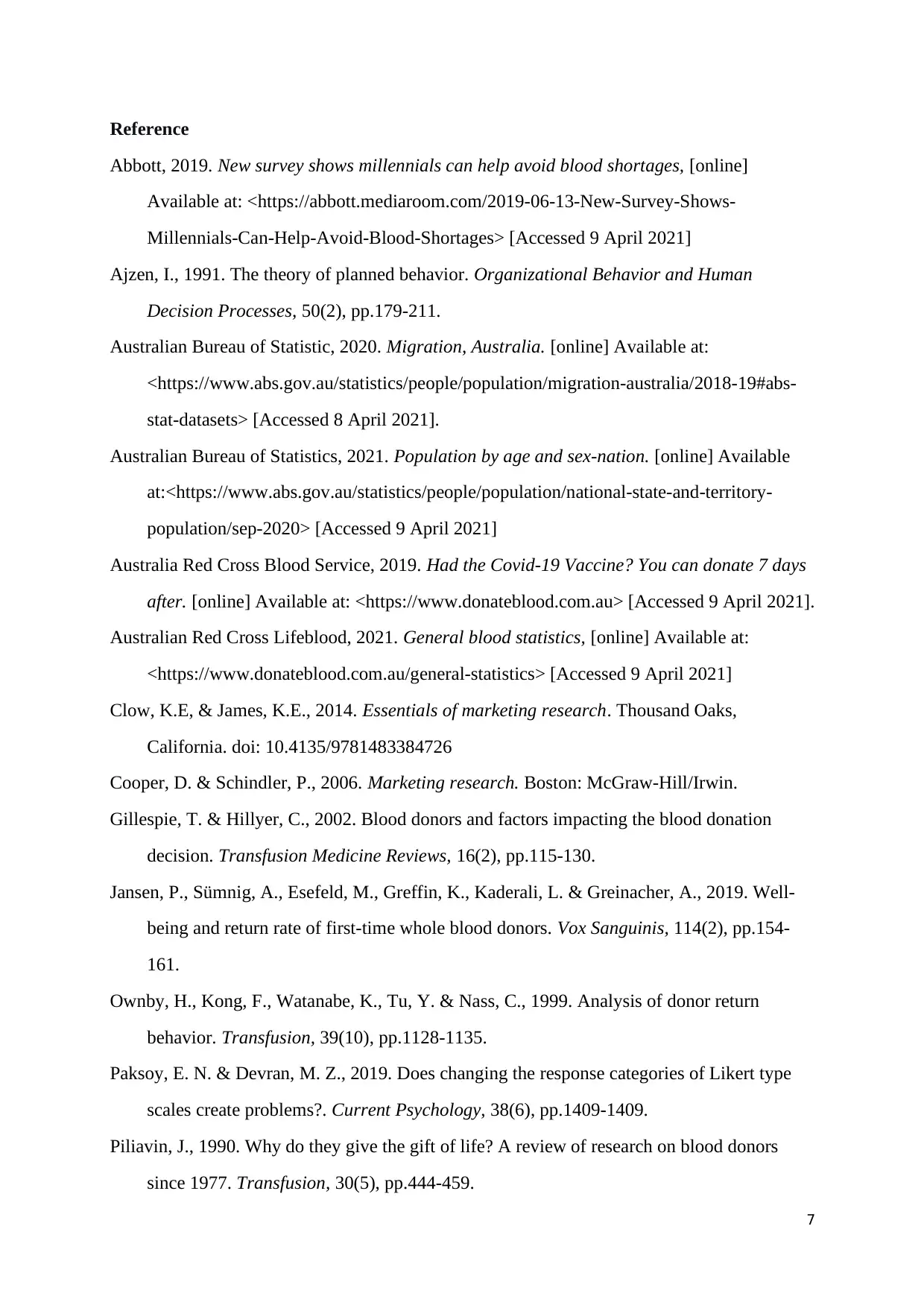
7
Reference
Abbott, 2019. New survey shows millennials can help avoid blood shortages, [online]
Available at: <https://abbott.mediaroom.com/2019-06-13-New-Survey-Shows-
Millennials-Can-Help-Avoid-Blood-Shortages> [Accessed 9 April 2021]
Ajzen, I., 1991. The theory of planned behavior. Organizational Behavior and Human
Decision Processes, 50(2), pp.179-211.
Australian Bureau of Statistic, 2020. Migration, Australia. [online] Available at:
<https://www.abs.gov.au/statistics/people/population/migration-australia/2018-19#abs-
stat-datasets> [Accessed 8 April 2021].
Australian Bureau of Statistics, 2021. Population by age and sex-nation. [online] Available
at:<https://www.abs.gov.au/statistics/people/population/national-state-and-territory-
population/sep-2020> [Accessed 9 April 2021]
Australia Red Cross Blood Service, 2019. Had the Covid-19 Vaccine? You can donate 7 days
after. [online] Available at: <https://www.donateblood.com.au> [Accessed 9 April 2021].
Australian Red Cross Lifeblood, 2021. General blood statistics, [online] Available at:
<https://www.donateblood.com.au/general-statistics> [Accessed 9 April 2021]
Clow, K.E, & James, K.E., 2014. Essentials of marketing research. Thousand Oaks,
California. doi: 10.4135/9781483384726
Cooper, D. & Schindler, P., 2006. Marketing research. Boston: McGraw-Hill/Irwin.
Gillespie, T. & Hillyer, C., 2002. Blood donors and factors impacting the blood donation
decision. Transfusion Medicine Reviews, 16(2), pp.115-130.
Jansen, P., Sümnig, A., Esefeld, M., Greffin, K., Kaderali, L. & Greinacher, A., 2019. Well-
being and return rate of first-time whole blood donors. Vox Sanguinis, 114(2), pp.154-
161.
Ownby, H., Kong, F., Watanabe, K., Tu, Y. & Nass, C., 1999. Analysis of donor return
behavior. Transfusion, 39(10), pp.1128-1135.
Paksoy, E. N. & Devran, M. Z., 2019. Does changing the response categories of Likert type
scales create problems?. Current Psychology, 38(6), pp.1409-1409.
Piliavin, J., 1990. Why do they give the gift of life? A review of research on blood donors
since 1977. Transfusion, 30(5), pp.444-459.
Reference
Abbott, 2019. New survey shows millennials can help avoid blood shortages, [online]
Available at: <https://abbott.mediaroom.com/2019-06-13-New-Survey-Shows-
Millennials-Can-Help-Avoid-Blood-Shortages> [Accessed 9 April 2021]
Ajzen, I., 1991. The theory of planned behavior. Organizational Behavior and Human
Decision Processes, 50(2), pp.179-211.
Australian Bureau of Statistic, 2020. Migration, Australia. [online] Available at:
<https://www.abs.gov.au/statistics/people/population/migration-australia/2018-19#abs-
stat-datasets> [Accessed 8 April 2021].
Australian Bureau of Statistics, 2021. Population by age and sex-nation. [online] Available
at:<https://www.abs.gov.au/statistics/people/population/national-state-and-territory-
population/sep-2020> [Accessed 9 April 2021]
Australia Red Cross Blood Service, 2019. Had the Covid-19 Vaccine? You can donate 7 days
after. [online] Available at: <https://www.donateblood.com.au> [Accessed 9 April 2021].
Australian Red Cross Lifeblood, 2021. General blood statistics, [online] Available at:
<https://www.donateblood.com.au/general-statistics> [Accessed 9 April 2021]
Clow, K.E, & James, K.E., 2014. Essentials of marketing research. Thousand Oaks,
California. doi: 10.4135/9781483384726
Cooper, D. & Schindler, P., 2006. Marketing research. Boston: McGraw-Hill/Irwin.
Gillespie, T. & Hillyer, C., 2002. Blood donors and factors impacting the blood donation
decision. Transfusion Medicine Reviews, 16(2), pp.115-130.
Jansen, P., Sümnig, A., Esefeld, M., Greffin, K., Kaderali, L. & Greinacher, A., 2019. Well-
being and return rate of first-time whole blood donors. Vox Sanguinis, 114(2), pp.154-
161.
Ownby, H., Kong, F., Watanabe, K., Tu, Y. & Nass, C., 1999. Analysis of donor return
behavior. Transfusion, 39(10), pp.1128-1135.
Paksoy, E. N. & Devran, M. Z., 2019. Does changing the response categories of Likert type
scales create problems?. Current Psychology, 38(6), pp.1409-1409.
Piliavin, J., 1990. Why do they give the gift of life? A review of research on blood donors
since 1977. Transfusion, 30(5), pp.444-459.
Paraphrase This Document
Need a fresh take? Get an instant paraphrase of this document with our AI Paraphraser
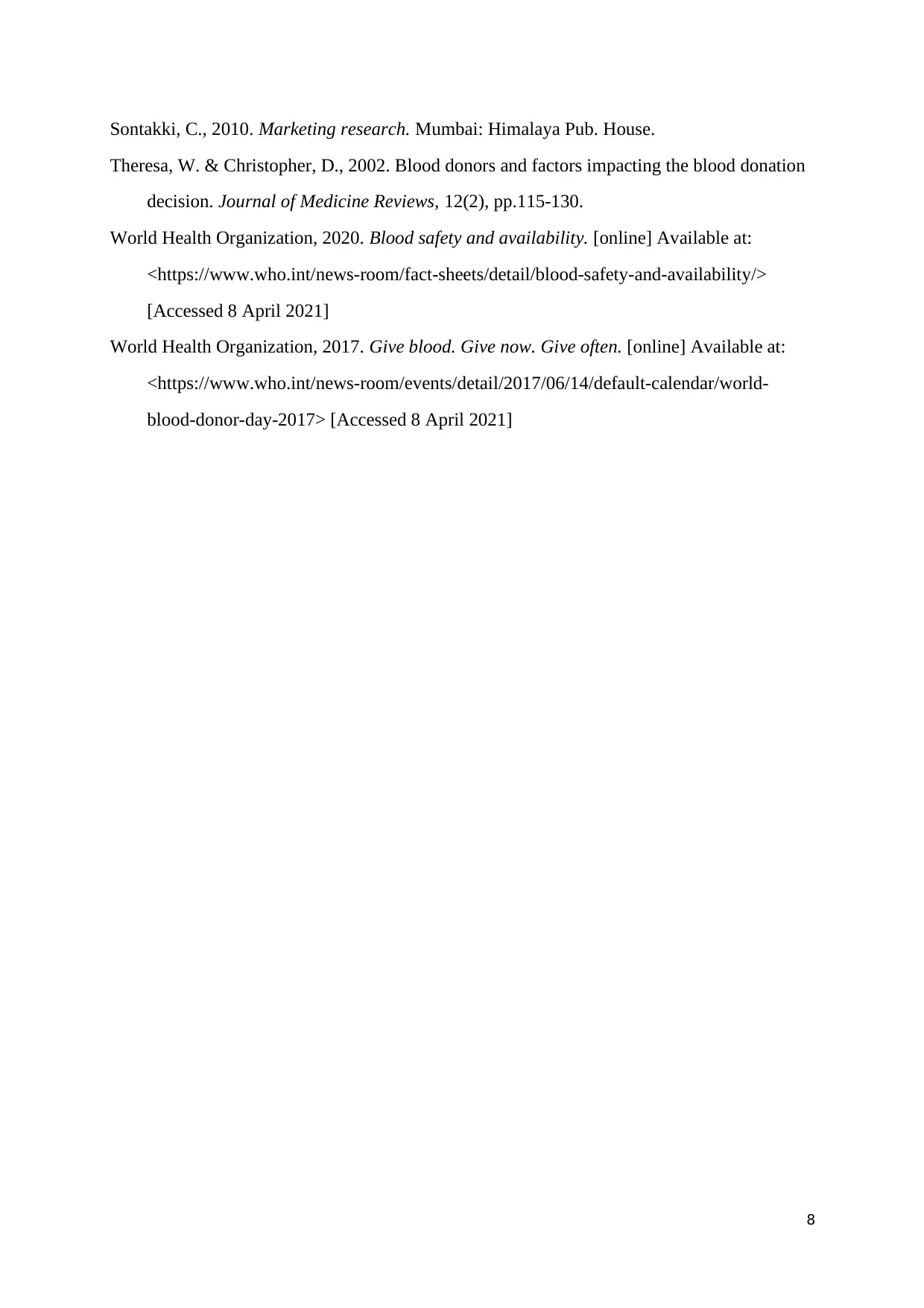
8
Sontakki, C., 2010. Marketing research. Mumbai: Himalaya Pub. House.
Theresa, W. & Christopher, D., 2002. Blood donors and factors impacting the blood donation
decision. Journal of Medicine Reviews, 12(2), pp.115-130.
World Health Organization, 2020. Blood safety and availability. [online] Available at:
<https://www.who.int/news-room/fact-sheets/detail/blood-safety-and-availability/>
[Accessed 8 April 2021]
World Health Organization, 2017. Give blood. Give now. Give often. [online] Available at:
<https://www.who.int/news-room/events/detail/2017/06/14/default-calendar/world-
blood-donor-day-2017> [Accessed 8 April 2021]
Sontakki, C., 2010. Marketing research. Mumbai: Himalaya Pub. House.
Theresa, W. & Christopher, D., 2002. Blood donors and factors impacting the blood donation
decision. Journal of Medicine Reviews, 12(2), pp.115-130.
World Health Organization, 2020. Blood safety and availability. [online] Available at:
<https://www.who.int/news-room/fact-sheets/detail/blood-safety-and-availability/>
[Accessed 8 April 2021]
World Health Organization, 2017. Give blood. Give now. Give often. [online] Available at:
<https://www.who.int/news-room/events/detail/2017/06/14/default-calendar/world-
blood-donor-day-2017> [Accessed 8 April 2021]
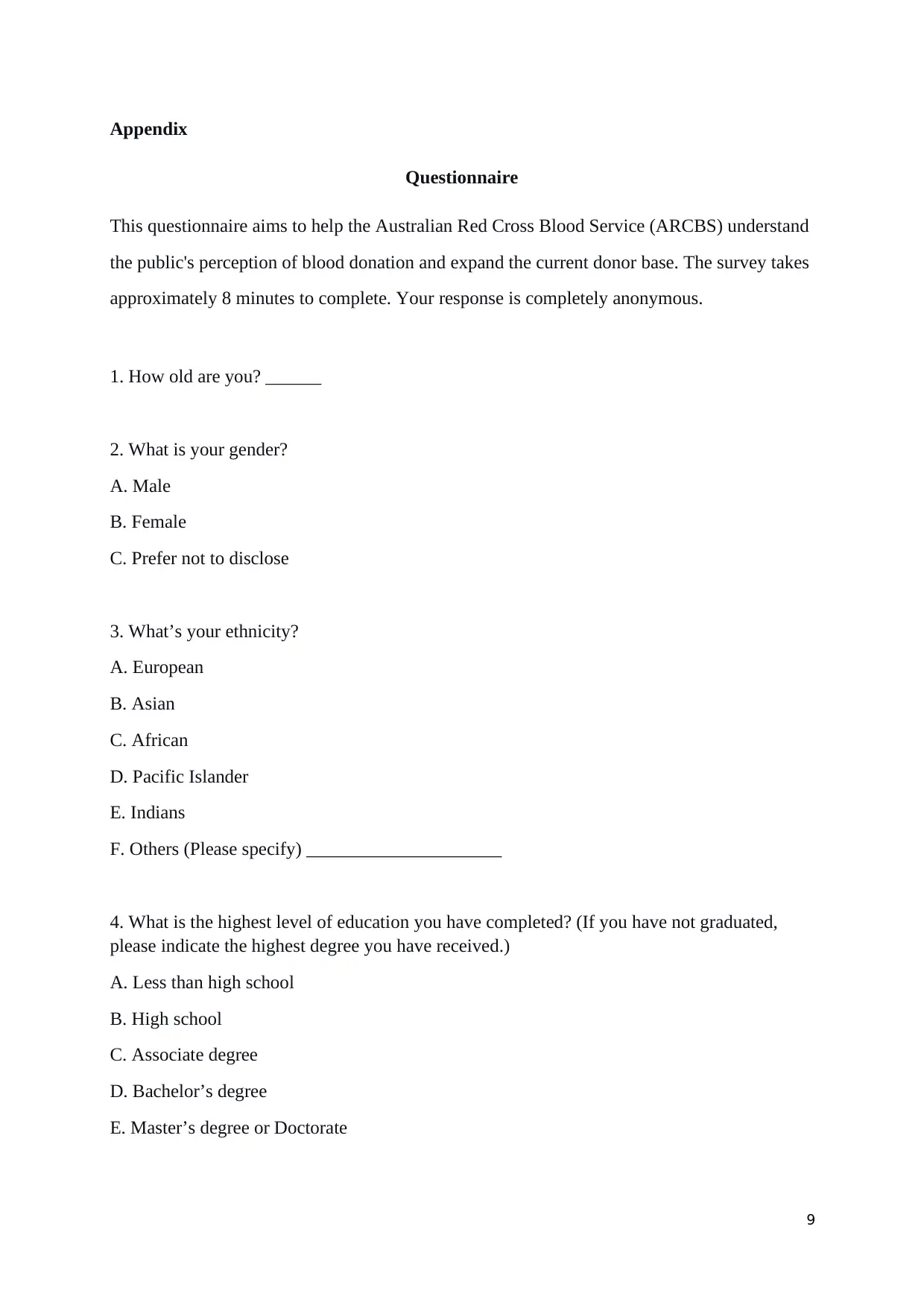
9
Appendix
Questionnaire
This questionnaire aims to help the Australian Red Cross Blood Service (ARCBS) understand
the public's perception of blood donation and expand the current donor base. The survey takes
approximately 8 minutes to complete. Your response is completely anonymous.
1. How old are you? ______
2. What is your gender?
A. Male
B. Female
C. Prefer not to disclose
3. What’s your ethnicity?
A. European
B. Asian
C. African
D. Pacific Islander
E. Indians
F. Others (Please specify) _____________________
4. What is the highest level of education you have completed? (If you have not graduated,
please indicate the highest degree you have received.)
A. Less than high school
B. High school
C. Associate degree
D. Bachelor’s degree
E. Master’s degree or Doctorate
Appendix
Questionnaire
This questionnaire aims to help the Australian Red Cross Blood Service (ARCBS) understand
the public's perception of blood donation and expand the current donor base. The survey takes
approximately 8 minutes to complete. Your response is completely anonymous.
1. How old are you? ______
2. What is your gender?
A. Male
B. Female
C. Prefer not to disclose
3. What’s your ethnicity?
A. European
B. Asian
C. African
D. Pacific Islander
E. Indians
F. Others (Please specify) _____________________
4. What is the highest level of education you have completed? (If you have not graduated,
please indicate the highest degree you have received.)
A. Less than high school
B. High school
C. Associate degree
D. Bachelor’s degree
E. Master’s degree or Doctorate
⊘ This is a preview!⊘
Do you want full access?
Subscribe today to unlock all pages.

Trusted by 1+ million students worldwide
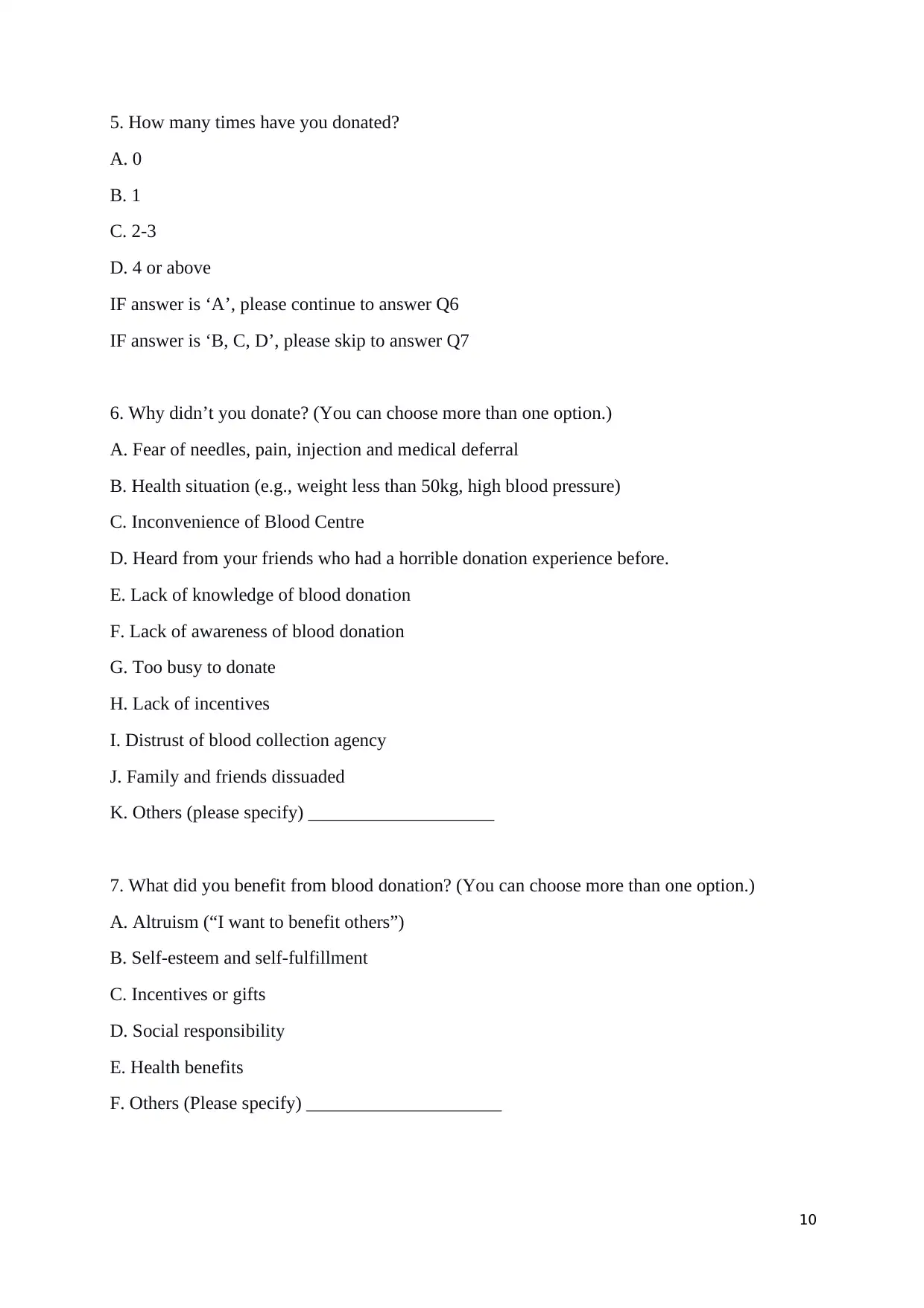
10
5. How many times have you donated?
A. 0
B. 1
C. 2-3
D. 4 or above
IF answer is ‘A’, please continue to answer Q6
IF answer is ‘B, C, D’, please skip to answer Q7
6. Why didn’t you donate? (You can choose more than one option.)
A. Fear of needles, pain, injection and medical deferral
B. Health situation (e.g., weight less than 50kg, high blood pressure)
C. Inconvenience of Blood Centre
D. Heard from your friends who had a horrible donation experience before.
E. Lack of knowledge of blood donation
F. Lack of awareness of blood donation
G. Too busy to donate
H. Lack of incentives
I. Distrust of blood collection agency
J. Family and friends dissuaded
K. Others (please specify) ____________________
7. What did you benefit from blood donation? (You can choose more than one option.)
A. Altruism (“I want to benefit others”)
B. Self-esteem and self-fulfillment
C. Incentives or gifts
D. Social responsibility
E. Health benefits
F. Others (Please specify) _____________________
5. How many times have you donated?
A. 0
B. 1
C. 2-3
D. 4 or above
IF answer is ‘A’, please continue to answer Q6
IF answer is ‘B, C, D’, please skip to answer Q7
6. Why didn’t you donate? (You can choose more than one option.)
A. Fear of needles, pain, injection and medical deferral
B. Health situation (e.g., weight less than 50kg, high blood pressure)
C. Inconvenience of Blood Centre
D. Heard from your friends who had a horrible donation experience before.
E. Lack of knowledge of blood donation
F. Lack of awareness of blood donation
G. Too busy to donate
H. Lack of incentives
I. Distrust of blood collection agency
J. Family and friends dissuaded
K. Others (please specify) ____________________
7. What did you benefit from blood donation? (You can choose more than one option.)
A. Altruism (“I want to benefit others”)
B. Self-esteem and self-fulfillment
C. Incentives or gifts
D. Social responsibility
E. Health benefits
F. Others (Please specify) _____________________
Paraphrase This Document
Need a fresh take? Get an instant paraphrase of this document with our AI Paraphraser
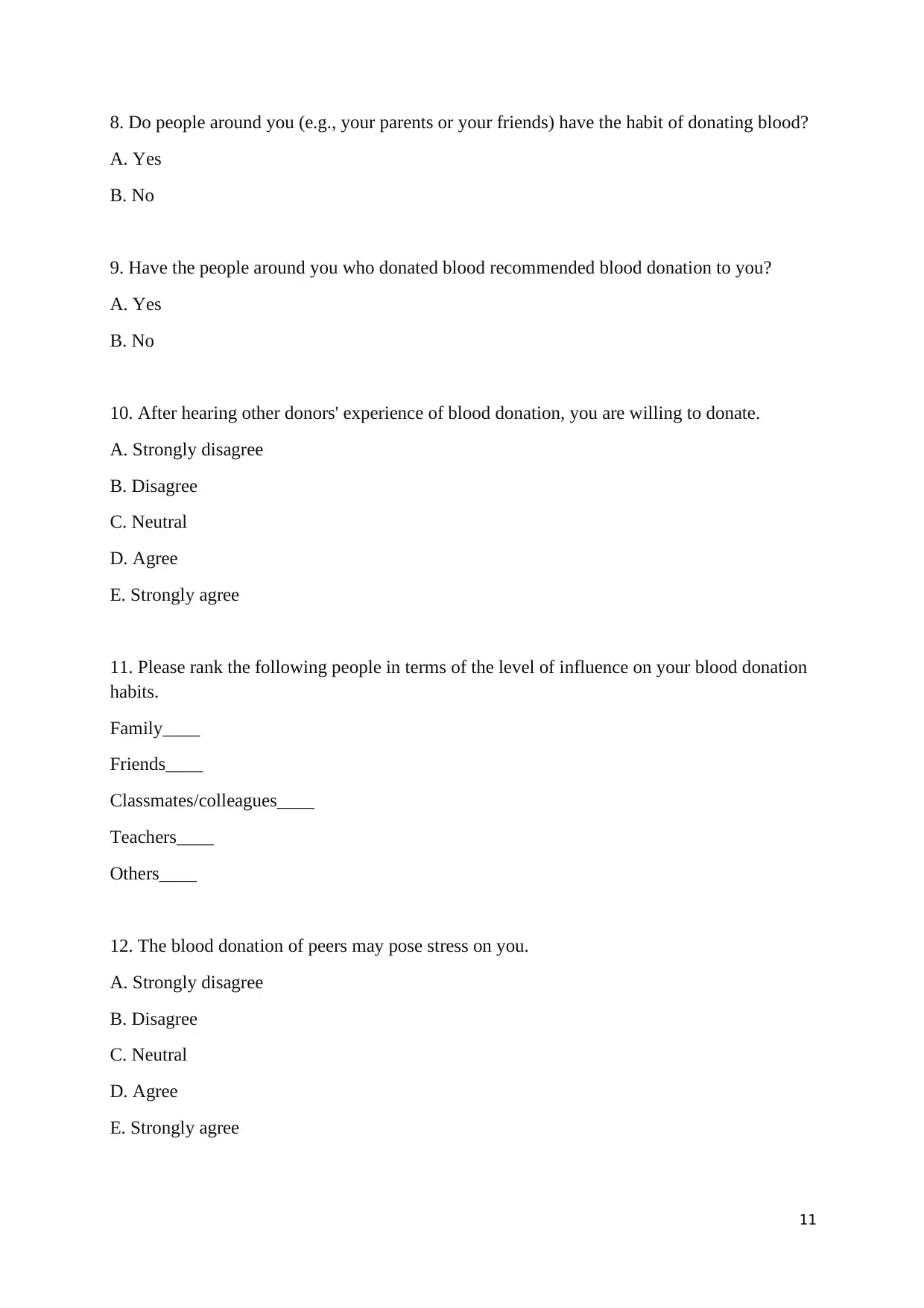
11
8. Do people around you (e.g., your parents or your friends) have the habit of donating blood?
A. Yes
B. No
9. Have the people around you who donated blood recommended blood donation to you?
A. Yes
B. No
10. After hearing other donors' experience of blood donation, you are willing to donate.
A. Strongly disagree
B. Disagree
C. Neutral
D. Agree
E. Strongly agree
11. Please rank the following people in terms of the level of influence on your blood donation
habits.
Family____
Friends____
Classmates/colleagues____
Teachers____
Others____
12. The blood donation of peers may pose stress on you.
A. Strongly disagree
B. Disagree
C. Neutral
D. Agree
E. Strongly agree
8. Do people around you (e.g., your parents or your friends) have the habit of donating blood?
A. Yes
B. No
9. Have the people around you who donated blood recommended blood donation to you?
A. Yes
B. No
10. After hearing other donors' experience of blood donation, you are willing to donate.
A. Strongly disagree
B. Disagree
C. Neutral
D. Agree
E. Strongly agree
11. Please rank the following people in terms of the level of influence on your blood donation
habits.
Family____
Friends____
Classmates/colleagues____
Teachers____
Others____
12. The blood donation of peers may pose stress on you.
A. Strongly disagree
B. Disagree
C. Neutral
D. Agree
E. Strongly agree
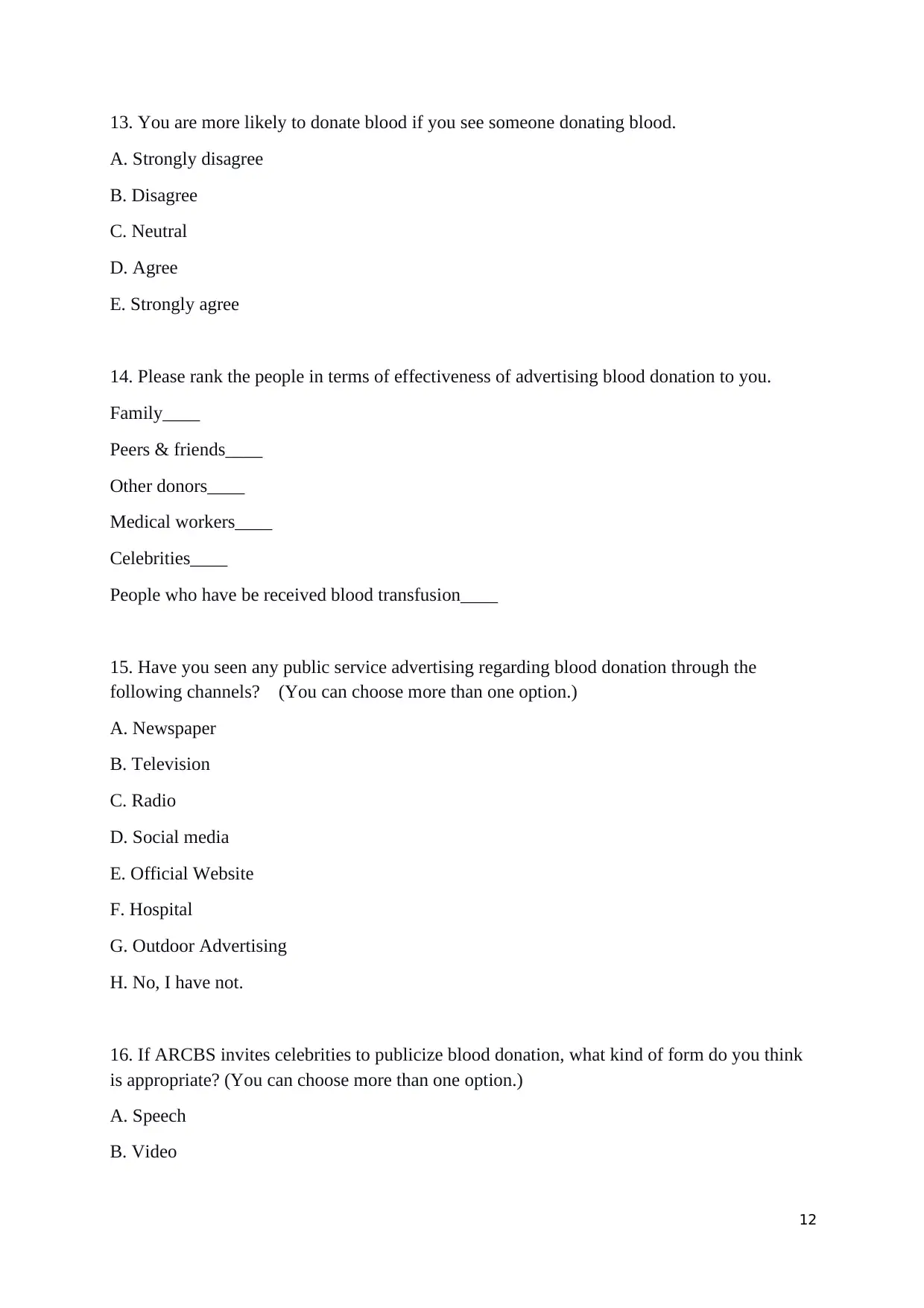
12
13. You are more likely to donate blood if you see someone donating blood.
A. Strongly disagree
B. Disagree
C. Neutral
D. Agree
E. Strongly agree
14. Please rank the people in terms of effectiveness of advertising blood donation to you.
Family____
Peers & friends____
Other donors____
Medical workers____
Celebrities____
People who have be received blood transfusion____
15. Have you seen any public service advertising regarding blood donation through the
following channels? (You can choose more than one option.)
A. Newspaper
B. Television
C. Radio
D. Social media
E. Official Website
F. Hospital
G. Outdoor Advertising
H. No, I have not.
16. If ARCBS invites celebrities to publicize blood donation, what kind of form do you think
is appropriate? (You can choose more than one option.)
A. Speech
B. Video
13. You are more likely to donate blood if you see someone donating blood.
A. Strongly disagree
B. Disagree
C. Neutral
D. Agree
E. Strongly agree
14. Please rank the people in terms of effectiveness of advertising blood donation to you.
Family____
Peers & friends____
Other donors____
Medical workers____
Celebrities____
People who have be received blood transfusion____
15. Have you seen any public service advertising regarding blood donation through the
following channels? (You can choose more than one option.)
A. Newspaper
B. Television
C. Radio
D. Social media
E. Official Website
F. Hospital
G. Outdoor Advertising
H. No, I have not.
16. If ARCBS invites celebrities to publicize blood donation, what kind of form do you think
is appropriate? (You can choose more than one option.)
A. Speech
B. Video
⊘ This is a preview!⊘
Do you want full access?
Subscribe today to unlock all pages.

Trusted by 1+ million students worldwide
1 out of 14
Related Documents
Your All-in-One AI-Powered Toolkit for Academic Success.
+13062052269
info@desklib.com
Available 24*7 on WhatsApp / Email
![[object Object]](/_next/static/media/star-bottom.7253800d.svg)
Unlock your academic potential
Copyright © 2020–2025 A2Z Services. All Rights Reserved. Developed and managed by ZUCOL.





